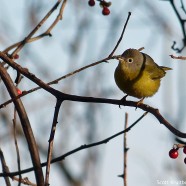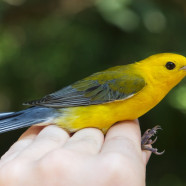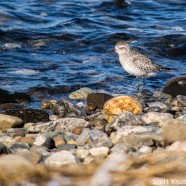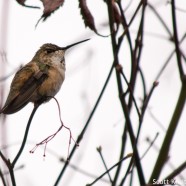Long-tailed Ducks (Clangula hyemalis)
It is December duck time! I have been enjoying some of the new arrivals across our region as birds like Red-breasted Mergansers, Common Goldeneyes, Greater and Lesser Scaups, Ring-necked Ducks, Redheads, and these Long-tailed Ducks make their way to our shores. This species of diving duck certainly spends a long time underwater when it is feeding. It can even go down to near 200 feet! Their incredible patterns almost appeared camouflaged against the water on this cloudy late autumn day. Scott Kruitbosch Conservation & Outreach Coordinator
Read MoreNashville Warbler (Oreothlypis ruficapilla)
Happy Thanksgiving! Many Thanksgivings ago I was watching my bird feeders at my parent’s house in Connecticut while waiting for family to arrive and dinner to begin on a cool, rainy day. While looking out the window I spotted, naked eye, an oddly shaped and surprisingly brightly colored bird on a tree branch. I grabbed my binoculars very quickly and had a good look at a warbler inspecting the feeding area and all of the bird commotion below it. It had a yellow body, dark green on the back and wings, a gray hood and very bright white eye rings. It was a Nashville Warbler! Their...
Read MoreTropical research and conservation season coming soon!
The tropical research and conservation season is coming up soon for the Roger Tory Peterson Institute of Natural History and its staff, affiliates, students and interns. RTPI staff carries out several active research and education initiatives in Central America. We coordinate student research programs in Panama and Costa Rica, run active banding stations in those countries to study migratory birds on their wintering grounds and carry out important conservation research on some of the most endangered amphibian species in the region. You can find more information about some of our programs...
Read MoreBlack-bellied Plover (Pluvialis squatarola)
Even when the Black-bellied Plover (Pluvialis squatarola) is not quite living up to its name during the non-breeding season it still has a surprisingly appealing look. The plumage may initially seem dull but when it takes flight it flashes some of that namesake color with its black axillars and an always white rump and tail. The species can be found hanging out on the Atlantic Coast in many locations during the late autumn and winter. It is a bird we record nearly year-round for our work in the Audubon Alliance for Coastal Waterbirds.
Read MoreRufous Hummingbird and vagrancy
This past weekend I was able to briefly visit and photograph a vagrant hummingbird from the west at an undisclosed location in Connecticut. I was told of the sighting by two experts who had documented the bird a couple hours earlier, confirming via observations and photos that this was a Rufous Hummingbird (Selasphorus rufus), and not the very easy to confuse Allen’s Hummingbird (Selasphorus sasin) which would have been even more rare. The bird pictured below is an immature female. She paused only briefly in the tree being otherwise occupied and somewhat anxious, zipping back and...
Read More








